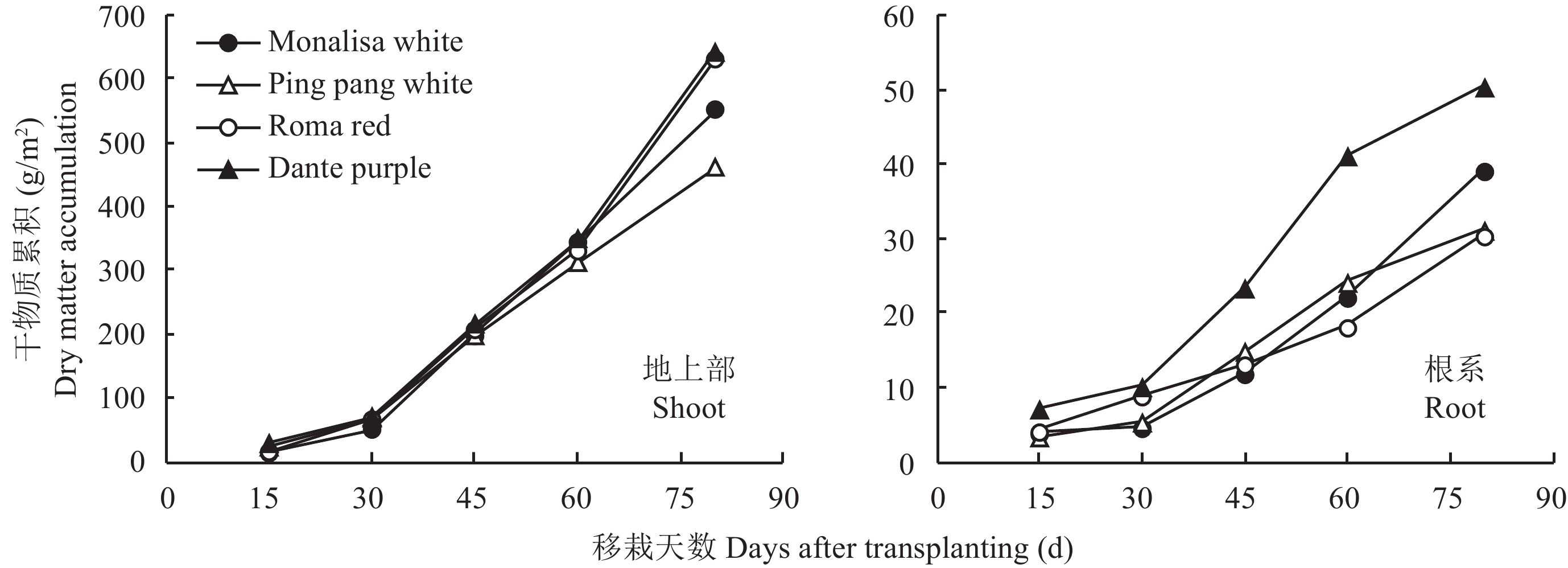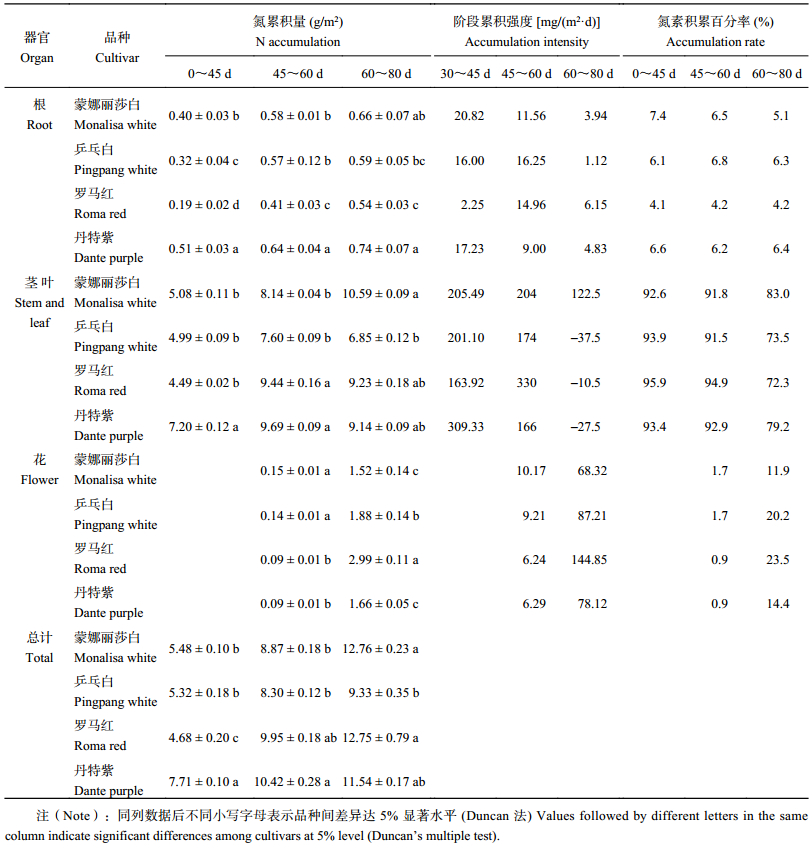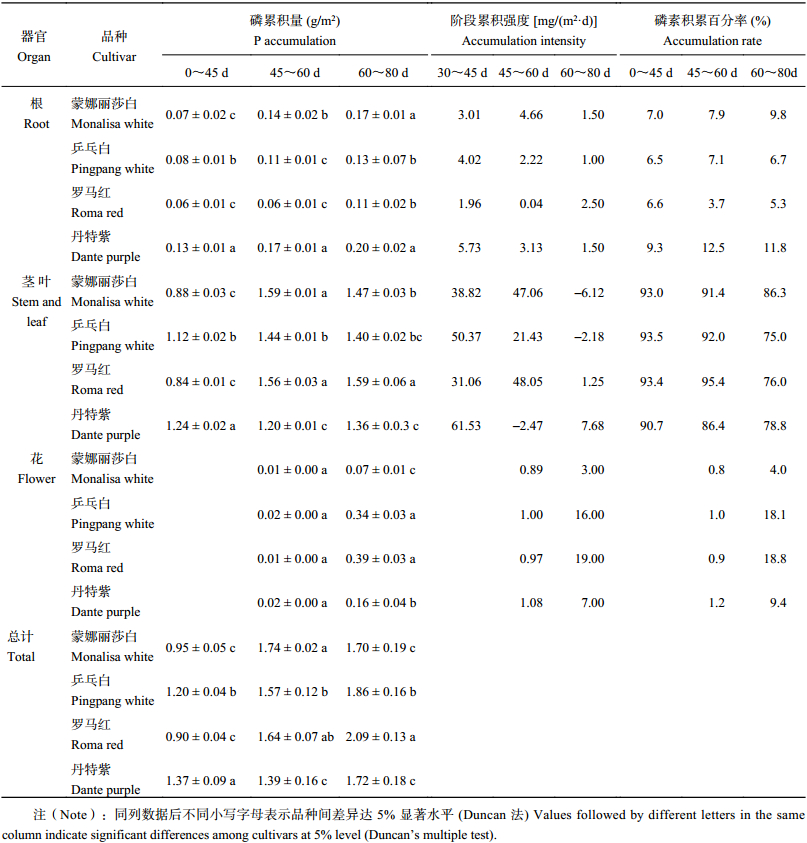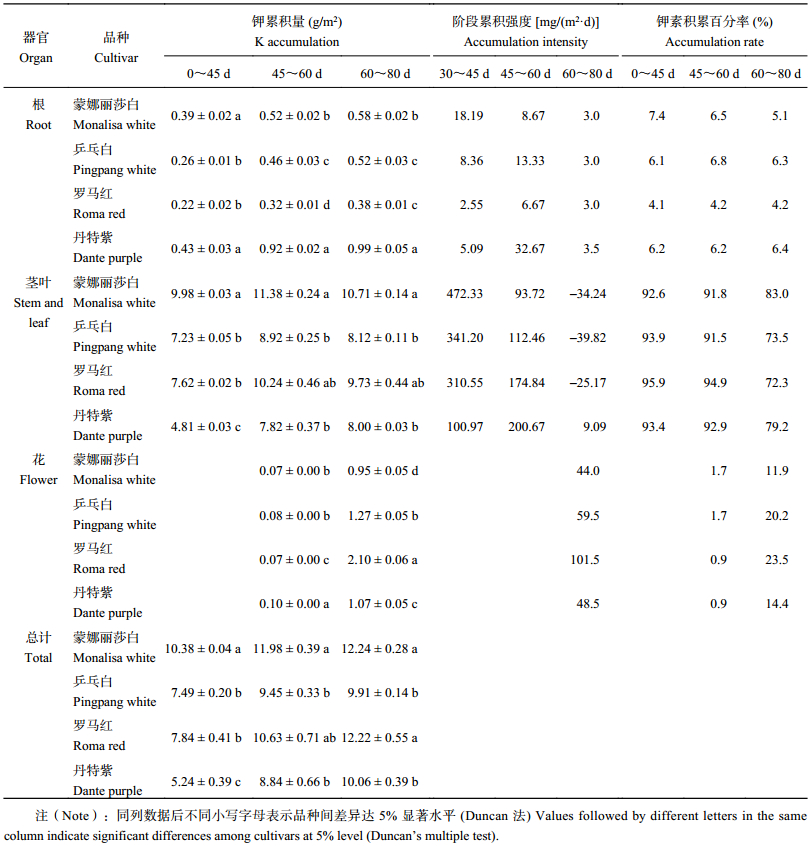菊花是菊科菊属多年生宿根草本植物,同时也是四大切花之一。昆明作为国内主要花卉生产区之一,已然成为中国最大切花交易市场,而切花菊的比重占到我国切花生产总量的30.1%。大量研究表明,氮磷钾的吸收、累积在植株生长发育过程中有着至关重要的作用[1–4],目前关于切花菊的研究国内更多集中在病害、保鲜和栽培技术等方面[5–9]。近几年对药用菊花,如杭白菊、怀花菊的氮磷钾养分吸收特性多有研究。张朋等[10]和祝丽香等[11]研究表明,NH4+-N/NO3–-N为25∶75时较利于杭白菊的生长及品质提升;杭白菊N、P2O5、K2O吸收比例为1∶0.88∶1.58。野菊花适宜的N、P、K肥施用量分别为131.280~187.254 kg/hm2、113.415~170.460 kg/hm2、118.335~220.845 kg/hm2[12]。李丽伟等[13]研究表明在2763.13 kg/hm2的产量水平下,每公顷怀菊花吸氮193.42 kg,平均生产1 kg干花需吸收氮0.07 kg。但目前对于设施条件下,切花菊氮、磷、钾养分吸收特性研究仅局限于一个品种。本文选取4个引进主栽品种,对其不同生育期的养分需求特性进行探究。旨在明确设施条件下其养分需求规律,更好地进行科学施肥,为建立高产高效的施肥体系提供理论依据和技术指导。
1 材料与方法 1.1 供试材料试验在云南省富民县云南丰岛花卉有限公司种植基地 (N25°22.5′,E102°30′) 保温式双层塑料大棚中进行。供试土壤为红壤,其基本理化性状:pH 6.3、碱解氮278.2 mg/kg、有效磷131.1 mg/kg、速效钾177.1 mg/kg、有机质70.8 g/kg。试验花卉选取四个引进主栽品种,分别为蒙娜丽莎白 (Monalisa white)、乒乓白 (Pingpang white)、罗马红 (Roma red) 和丹特紫 (Dante purple)。
1.2 试验设计田间试验小区面积为20 m2,基质育苗植株于2015年10月20日移栽,定植于10 cm × 10 cm的网格中,种植密度为75株/m 2,2016年1月20日收获切花。每个品种重复3次,随机区组排列。
供试肥料按照昆明设施菊花基地切花菊的常规方式,采用N∶P2O5∶K2O比例为15∶15∶15的复合肥。基施750 kg/hm2,于2015年12月5日 (花芽分化期) 追施450 kg/hm2。补光、遮光时间和水分补充 (滴灌) 均按基地常规设施菊花管理。
1.3 取样与分析每个小区分别于移栽后15 d (根生长期)、30 d (茎生长期)、45 d (花芽分化期)、60 d (现蕾期)、80 d (收获期),按“S”型多点取样30株。测定植株的观赏性状 (株高、叶片数、茎粗、花茎粗、花苞数和鲜重),茎粗和花茎粗用游标卡尺进行测定。分别取植株的根、茎、叶、花,105°杀青30 min,60~70°C烘干制取样品,粉碎,充分混合后备用。用H2SO4–H2O2消煮,凯氏定氮法测定全氮,钒钼黄比色法测定全磷,火焰光度计法测定全钾含量[14]。
有关参数计算如下:
养分阶段累积强度 = (所求时期养分累积量–前期养分累积量)/间隔采样天数
器官养分分配率 = 该器官养分累积量/植株养分总累积量 × 100%
1.4 数据处理与分析试验数据用Microsoft Excel 2016处理,用SPSS19.0软件进行多重比较分析。
2 结果与分析 2.1 不同品种切花菊观赏性状由表1可知,不同品种的茎粗并无显著差异。菊花鲜重以丹特紫最大,相较于其他3个品种显著增加了14.2%~29.5%;其次是乒乓白,相较于其他2个品种显著增加了15.6%~17.8%;罗马红略高于蒙娜丽莎白,但差异不显著。蒙娜丽莎白的株高相较于其他3个品种,显著增加了19.0%;其次是罗马红,乒乓白和丹特紫最小。丹特紫的每株叶片数相较于其他3个品种显著减少了14.2%~32.9%,而花茎粗显著高于其他3个品种。菊花花苞数以丹特紫和罗马红相对较高,蒙娜丽莎白次之,乒乓白最小。
| 表1 不同品种切花菊单株观赏性状 Table 1 Ornamental character of different chrysanthemum cultivars |
 |
品种差异不会影响干物质累积趋势,但累积量差异显著 (图1)。移栽45 d后,蒙娜丽莎白、乒乓白、罗马红根部干物质累积量分别占到整个生育期累积的14.6%、27.0%、18.9%;60 d后,占比分别为30.5%、17.6%、24.2%;80 d后,以丹特紫根部干物质累积最大,而罗马红最小,占到丹特紫的60.4%。地上部干物质累积量在移栽15 d时,丹特紫显著高于其他品种,增幅为19.0%~50.0%,乒乓白次之,蒙娜丽莎白和罗马红最小。移栽80 d后,地上部干物质累积量达到整个生育期的峰值,以丹特紫相对较高,达639.75 g/m2。
 |
| 图1 不同品种切花菊干物质累积变化 Fig. 1 Dry matter accumulation of different chrysanthemum cultivars |
2.3.1 氮素累积分配特征 由表2可知,移栽45 d时,氮主要累积在叶片和茎中,分配率为92.6%~95.9%,根系的分配率仅为4.1%~7.4%。移栽60 d时,茎、叶和根系的氮素累积逐渐减少,花蕾逐渐增加。移栽80 d时,花氮素累积量迅速增加,分配率为11.9%~23.4%。
| 表2 移栽后不同天数切花菊氮素累积分配特征 Table 2 N accumulation and distribution of different chrysanthemum cultivars after transplanting |
 |
移栽45~80 d时,丹特紫根系氮累积量显著高于其他品种,其次是蒙娜丽莎白和乒乓白,罗马红累积量最小。移栽45 d后,茎、叶氮累积量丹特紫相较于其他3个品种,显著增加了29.4%~37.6%;30~45 d茎叶累积强度以丹特紫最高,罗马红最小。移栽60 d,罗马红和丹特紫茎叶氮累积量相较于蒙娜丽莎白和乒乓白,显著增加了13.8%~21.6%;45~60 d罗马红的阶段累积强度最大,其次是蒙娜丽莎白。移栽80 d后,罗马红的花氮累积量最大,蒙娜丽莎白和丹特紫最小,仅为罗马红的53.8%、55.5%。表2也表明,蒙娜丽莎白和罗马红的氮吸收能力最强,其次是丹特紫,乒乓白氮吸收能力最小。
2.3.2 磷素累积分配特征 由表3可知,移栽后45 d,磷素主要累积在茎叶中,其分配率为90.7%~93.5%。移栽80 d时,茎叶、根的磷素累积逐渐减少,此时花的分配率为4.0%~18.1%;各器官的磷素累积量为茎叶 > 花 > 根。丹特紫和乒乓白磷素累积强度峰值高达61.53 mg/(m 2·d)、50.37 mg/(m2·d)。
| 表3 移栽后不同天数切花菊磷素累积分配特征 Table 3 P accumulation and distribution of different chrysanthemum cultivars after transplanting |
 |
不同品种比较,移栽45 d,丹特紫根系磷素累积相较于其他3个品种,显著增加了38.5%~53.8%,其次是乒乓白;茎叶磷素累积以丹特紫最高,乒乓白次之,蒙娜丽莎白和罗马红最小。移栽60 d,丹特紫根系磷累积显著高于其他3个品种,增幅为17.6%~64.7%,而丹特紫茎叶磷素累积量显著低于其他3个品种。移栽80 d,罗马红茎叶磷素累积量最高,丹特紫的最小;乒乓白和罗马红根系累积显著小于其他两个品种,但花中磷素累积显著高于其他品种。表3也表明,罗马红的磷吸收能力最强,其次是乒乓白和丹特紫,蒙娜丽莎白磷吸收能力较差。
2.3.3 钾素累积分配特征 由表4可知,移栽45d时,钾素主要累积在茎叶中,分配率为92.6%~95.9%;移栽60 d,茎叶、根中的磷素累积逐渐减少。移栽80 d时,钾素累积甚至出现负吸收,跟氮素累积相似。各器官的钾素累积为茎叶 > 花 > 根。各器官钾素累积强度峰值出现的时间因品种不同而异。在移栽45~80 d时,丹特紫根系钾素累积量显著高于其他3个品种,罗马红根系累积量最小。移栽45 d,丹特紫茎叶钾素累积量显著低于其他3个品种,平均降幅为72.1%。移栽60~80 d,蒙娜丽莎白茎叶钾素累积相较于罗马红略高,但差异不显著。茎叶在45~80 d,乒乓白、罗马红、蒙娜丽莎白茎叶阶段累积强度峰值出现在花芽分化期,而丹特紫峰值延迟至现蕾期。表4也表明,蒙娜丽莎白钾素吸收能力最强,其次是罗马红和丹特紫,乒乓白钾吸收能力较差。
| 表4 移栽后不同天数切花菊钾素累积分配特征 Table 4 K accumulation and distribution of different chrysanthemum cultivars after transplanting |
 |
由表5可知,切花菊品种不同,其百枝花所需要的养分量及其比例也有很大差异。蒙娜丽莎白和罗马红需氮、钾量相较于其他2个品种,分别平均显著增加了19.7%、22.8%。罗马红需磷量相较蒙娜丽莎白和丹特紫,平均显著增加了22.8%。不同品种切花菊对养分的吸收量均表现为K2O > N > P 2O5。
| 表5 不同品种切花菊百枝花所需氮磷钾养分比例(N: P2O5: K2O)及数量 Table 5 The amounts and ratios of N, P2O5, K2O for forming 100 plants of different chrysanthemum cultivars |
 |
关于其他切花,如香石竹、郁金香、玫瑰[4–5, 16]多有研究报道,但对设施条件下,不同品种切花菊的研究尚少,本研究在设施同等栽培条件、施肥技术下,比较了4种引进切花菊品种特性,结果表明蒙娜丽莎白株高和丹特紫单支鲜重显著高于其他3个品种。品种不同不会影响干物质积累趋势,为近“S型”曲线增长,但会影响累积量[20–21],罗马红和丹特紫地上部干物质累积平均为634.63 g/m2,显著高于其他2个品种;丹特紫地下部干物质累积量和鲜重显著高于其他3个品种,分别为50.5 g/m2、67.10 g/plant;乒乓白根系干物质累积量相对较低,为丹特紫的61.88%,而鲜重以蒙娜丽莎白相对较低,为47.32 g/plant。
3.2 不同品种切花菊养分吸收本研究结果表明,不同品种间养分吸收差异显著,说明作物的遗传因素对切花菊的养分需求特性影响很大,这与前人对其他作物的研究结果一致[17–19]。姜蓉等[22]研究认为,M. Pink(粉色) 对氮、磷、钾的累积吸收量表现为N > K 2O > P 2O5,这与本试验研究结果不同,可能与移栽时间、光照有关,寒冷季节菊花含氮量相对下降,有利于提高抗寒性[23]。本研究也表明,氮磷钾素累积主要集中在茎、叶部,因品种不同,略有差异;移栽80 d,茎叶钾累积量甚至出现负吸收,以乒乓白最高,为 –39.82.5 mg/(m 2·d),这可能与叶片的自然脱落有关,这与吴旭银等[24]研究结果一致。蒙娜丽莎白和罗马红氮、钾量累积量显著均高于乒乓白和丹特紫。罗马红磷累积量显著高于蒙娜丽莎白和丹特紫,而乒乓白磷累积量略低于罗马红,差异并不显著。移栽45 d,养分主要集中在茎叶中,有利于植株的营养生长,随着生育进程的推进,养分逐渐向花中转移;到80 d,花的氮、磷、钾阶段累积吸收强度最大。对于切花菊施肥,尤其要注重花芽分化期养分供应。本试验是在设施常规施肥条件下,研究4种不同引进切花菊品种的养分吸收特性,试验中所得到的养分参数对于切花菊的营养诊断和施肥有重要的参考意义。本文中所选取的都是秋冬时期的不同品种切花菊,对于春夏时期的切花菊有待进一步研究。
4 结论1) 品种不同并不会改变切花菊干物质的累积趋势,但会影响累积量。丹特紫干物质量显著高于其他品种,乒乓白最低。
2) 在本试验种植条件下,不同品种切花菊氮磷钾的吸收、累积和分配存在着显著性差异,蒙娜丽莎白和罗马红氮、钾量累积量均显著高于乒乓白和丹特紫。罗马红磷累积量显著高于蒙娜丽莎白和丹特紫,而乒乓白与罗马红的磷素累积量差异不显著。4种主栽切花菊品种养分需求量以罗马红最高,乒乓白最小。对于切花菊罗马红,应尤其重视花芽分化期的养分供应。
| [1] | Choi J M, Shim C Y, Chung H J, et al. Effect of liming fertilization on changes of nutrient concentration in rice-hull based media, crop growth and nutrient uptake of chrysanthemum[J]. Journal of the Korean Society for Horticultural Science, 2001, 42(5): 553–556. |
| [2] | Shima K, Goto T, Kageyama T. The effects of fertilization application methods on cut flower quality and nutrient uptake by spray chrysanthemum in bench culture[J]. Horticulture Research, 2004, 3(1): 23–26. |
| [3] |
徐峥. 设施栽培仙客来养分吸收规律的初步研究[D]. 南京: 南京农业大学硕士学位论文, 2010.
Xu Z. Preliminary study on nutritive regulation of cyclamen under the facility cultivation [D]. Nanjing: MS Thesis of Nanjing Agricultural University, 2010. |
| [4] |
续勇波, 郑毅, 刘宏斌, 张维理. 保护地香石竹干物质积累和养分吸收特性研究[J].
北方园艺, 2004, (4): 69–71.
Xu Y B, Zheng Y, Liu H B, Zhang W L. Accumulation of dry matter and nutrient absorption in carnation of protected area[J]. Northern Horticulture, 2004, (4): 69–71. |
| [5] |
夏文通, 刘燕, 刘海鹏. 郁金香养分吸收及分配规律[J].
浙江农业学报, 2014, (3): 643–648.
Xia W T, Liu Y, Liu H P. Absorption and distribution of nitrogen, phosphorus and potassium in tulip[J]. Acta Agriculturae Zhejiangensis, 2014, (3): 643–648. |
| [6] |
郑春雷, 樊涛, 马海燕, 等. 多效唑对切花菊保鲜效果和生理作用的影响[J].
河南农业大学学报, 2011, (5): 519–522, 529.
Zheng C L, Fan T, Ma H Y, et al. Influence of paclobutrazol on freshness preservation effect and physiological action of cut chrysanthemum[J]. Journal of Henan Agricultural University, 2011, (5): 519–522, 529. |
| [7] |
李俊香, 温超, 刘凤栾, 等. 温度对切花菊‘深志’侧芽形成的影响[J].
中国农业大学学报, 2014, (1): 74–79.
Li J X, Wen C, Liu F L, et al. Effect of temperature on lateral bud formation of Chrysanthemum morifolium ‘fucashi’ [J]. Journal of China Agricultural University, 2014, (1): 74–79. |
| [8] |
王伟东, 杨迎东, 屈连伟, 等. 光照时间对切花菊‘白扇’生长的影响[J].
辽宁农业科学, 2014, (5): 19–22.
Wang W D, Yang Y D, Qu L W, et al. Effect of light time on the growth of cut chrysanthemum ‘Baishan’[J]. Liaoning Agricultural Sciences, 2014, (5): 19–22. |
| [9] | Rostami M, Zamani A A, GolDanteh S, et al. Influence of nitrogen fertilization on biology of Aphis gossypii (Hemiptera: Aphididae) reared on Chrysanthemum indicum (Asteraceae) [J]. Journal of Plant Protection Research, 2012, 52(1): 118–121. |
| [10] |
张朋, 王康才, 成明超, 等. 氮素形态对杭白菊生长及品质的影响[J].
中国中药杂志, 2014, (17): 3263–3268.
Zhang P, Wang K C, Cheng M C, et al. Effect of nitrogen form on growth and quality of Chrysanthemum morifolium[J]. China Journal of Chinese Materia Medica, 2014, (17): 3263–3268. |
| [11] |
祝丽香, 王建华, 孙印石, 马红兵. 杭白菊氮磷钾吸收、积累及分配规律研究[J].
中国中药杂志, 2009, 23: 2999–3003.
Zhu L X, Wang J H, Sun Y S, Ma H B. Absorption and distribution of nitrogen, phosphorus and potassium in Chrysanthemum indicum [J]. China Journal of Chinese Materia Medica, 2009, 23: 2999–3003. DOI:10.3321/j.issn:1001-5302.2009.23.004 |
| [12] |
张建海, 冯彬彬, 徐晓玉. N、P、K配施效应模型及对野菊花产量和质量的影响[J].
中草药, 2013, 44(11): 1495–1500.
Zhang J H, Feng B B, Xu X Y. Effect of fertilization combinations of nitrogen, phosphorus, and potassium on yield and quality of flowers in Chrysanthemum indicum [J]. Chinese Traditional and Herbal Drugs, 2013, 44(11): 1495–1500. DOI:10.7501/j.issn.0253-2670.2013.11.026 |
| [13] |
李丽伟. 怀菊花需肥规律与氮磷钾配施对其产量的影响[D]. 河南: 河南农业大学硕士学位论文, 2008.
Li L W. The absorption rule of fertilizer about Huai Flos Chrysanthemum and the combined application effect of nitrogen phosphorus and potassium fertilizer on its yield [D]. Henan: MS Thesis of Henan Agricultural University, 2008 |
| [14] |
鲍土旦. 土壤农化分析 (第三版)[M]. 北京: 中国农业出版社, 2005.
Bao S D. Soil agricultural chemistry analysis (Third Edition) [M]. Beijing: China Agriculture Press, 2005. |
| [15] |
史静, 程文娟, 张乃明. 施肥对切花玫瑰生长及养分吸收特性的影响[J].
中国土壤与肥料, 2012, (4): 59–64.
Shi J, Cheng W J, Zhang N M. Effect of fertilization on growth and nutrition absorption of cut roses[J]. Soil and Fertilizer Sciences in China, 2012, (4): 59–64. |
| [16] |
吕长文, 赵勇, 唐道彬. 不同类型甘薯品种氮、钾积累分配及其与产量性状的关系[J].
植物营养与肥料学报, 2012, 18(2): 475–482.
Lü C W, Zhao Y, Tang D B, et al. Accumulation and translocation of nitrogen and potassium and their relationships with yielding traits for different type cultivars of sweet potato[J]. Plant Nutrition and Fertilizer Science, 2012, 18(2): 475–482. DOI:10.11674/zwyf.2012.11217 |
| [17] |
房增国, 赵秀芬. 胶东地区不同花生品种的养分吸收分配特性[J].
植物营养与肥料学报, 2015, 21(1): 241–250.
Fang Z G, Zhao X F. Nutrient absorption and distribution characteristics of different peanut varieties in Jiaodong peninsula[J]. Journal of Plant Nutrition and Fertilizer, 2015, 21(1): 241–250. DOI:10.11674/zwyf.2015.0127 |
| [18] |
张阔, 孙志梅, 刘建涛, 等. 冀西北坝上地区不同萝卜品种的养分吸收特性比较[J].
植物营养与肥料学报, 2013, 19(1): 191–199.
Zhang K, Sun Z M, Liu J T, et al. Comparative studies on nutrient absorption characteristics of different radish varieties in the northwest area of Hebei Province[J]. Plant Nutrition and Fertilizer Science, 2013, 19(1): 191–199. |
| [19] |
李飒, 彭云峰, 于鹏, 等. 不同年代玉米品种干物质积累与钾素吸收及其分配[J].
植物营养与肥料学报, 2011, 17(2): 325–332.
Li S, Peng Y F, Yu P, et al. Accumulation and distribution of dry matter and potassium in maize varieties released in different years[J]. Plant Nutrition and Fertilizer Science, 2011, 17(2): 325–332. DOI:10.11674/zwyf.2011.0214 |
| [20] |
李录久, 郭熙盛, 丁楠, 等. 不同品种生姜的营养特性和养分吸收规律[J].
土壤通报, 2007, (6): 1237–1239.
Li L J, Guo X S, Ding N, et al. Nutrition characteristics and nutrient uptake pattern of different varieties of ginger[J]. Chinese Journal of Soil Science, 2007, (6): 1237–1239. |
| [21] |
董月, 安霞, 张辉, 等. 不同品种甘薯的生物量累积、养分吸收和分配规律[J].
江苏农业学报, 2016, (2): 313–318.
Dong Y, An X, Zhang H, et al. Biomass accumulation and nutrients uptake and distribution in sweet potato cultivars[J]. Jiangsu Journal of Agricultural Science, 2016, (2): 313–318. |
| [22] |
姜蓉, 徐智, 汤利, 等. 设施菊花荷兰多头菊氮磷钾养分吸收累积特征研究[A]. 中国土壤学会. 土壤肥料学术交流研讨会论文集[C]. 成都: 电子科技大学出版社, 2012: 571–577
Jiang R, Xu Z, Tang L, et al. Characteristics of N, P, K nutrient uptake and accumulation of Dutch Spray Chrysanthemum under greenhouse cultivation condition[A]. Soil Science Society of China. Proceedings of the Symposium on Soil and Fertilizer[C]. Chengdu: University of Electronic Technology of China Press, 2012: 571–577. |
| [23] |
郑路. 菊花抗寒性与营养特性的研究[J].
园艺学报, 1994, 21(2): 185–188.
Zheng L. Studies on the cold resistance and nutrition characteristic of Chrysanthemum[J]. Acta Horticulturae Sinica, 1994, 21(2): 185–188. |
| [24] |
吴旭银, 吴贺平, 张淑霞, 等. 花生地膜覆盖栽培氮磷钾的吸收特性[J].
河北科技师范学院学报, 2007, 21(1): 29–33.
Wu X Y, Wu H P, Zhang X X, et al. Assimilation characteristics of nitrogen, phosphorus and potassium in plastic film-cultivated peanut[J]. Journal of Hebei Normal University of Science and Technology, 2007, 21(1): 29–33. |
 2017, Vol. 23
2017, Vol. 23  doi:
doi: 

